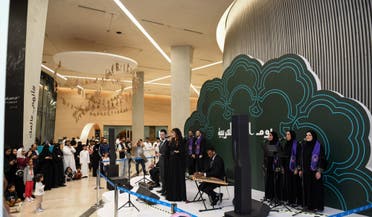“Ithra” restores the history of the Muwashahat, in order to activate the International Day of the Arabic Language

In the spirit of challenge and the passion for knowledge, contestants challenged the Andalusian muwashshahs, which were revived by the King Abdulaziz Center for World Culture (Ithraa) to commemorate the International Day of the Arabic Language, where many families and those interested lined up to participate in an event entitled “A Challenge Travels”, in which the contestant tours several stations. To reach the final destination through a number of questions and linguistic structures, while other activities spread a literary atmosphere that took visitors to the world of muwashshahat since its inception and formation.
Literary legacy
And because the stanzas have a literary heritage since historical eras, the activities held by Ithraa over the course of 3 days included a dialogue session entitled “The stanzas between composition and construction”, where the participants expressed that “the origins of the stanzas have not been decided to this day.” The researcher and thinker, Dr. Abdullah Ibrahim, added that the origins of the muwashshahs preoccupied the ancient and modern thinkers, but they relied on 3 theories of their origin. And the West, and this is called the Orientalist theory, as it was noted that the art of muwashshahs has become withdrawn from consideration in the current era because of its inability to represent the phenomena and conditions of society, and this applies to the art of maqamat, indicating that the revival of these ancient arts contributes to the harvest of literary wealth that reveals the cover of the golden age for Arab culture.
Public presence in Ithra
Arabic Muwashahat
The thinker explained that the number of well-known Arabic Muwashahs reaches 500, while the number of Maqamat doubles at a rate of 2,500, noting that literature is not islands separated from each other. The Arab must be influencing others, saying: “This idea has clouded our minds for centuries and must be disposed of, as cultural environments are affected and affected.”
While Dr. Muhammad Al-Omari (writer and professor at King Khalid University) considered that the poem and Arabic poetry are one of the main aspects of Arab culture. The anthologies of the Arabic language are diverse according to his description, adding that “eloquent poetry does not compete with other types of poetry,” adding that “the origin of the muwashshaat is narrative and other.” My poetry, as it has taken care of Arab and non-Arab society for more than a thousand years. At the forefront of what was discussed during the session, which lasted about two hours, in the presence of many writers, writers, and specialists in cultural affairs, was how to access the details of the muwashshahs that some considered to be “poems”, which are recited in gatherings due to their eloquence, as they are not bound by the unity of meter and rhyme, and were often used In praise, description and pride.

Within the program of the International Day of the Arabic Language
Thrill and passion
In parallel, the entire activities revolved around the element of suspense and passion, as the children participated in interactive activities, including “Words Without Points”, while others moved to take on the challenge with the “Travel Challenge” activity, where a set of questions about the Alhambra Palace related to the poems that were inscribed on its walls in Granada, and another revolves around the muwashahat of the palace and the poets who sang it, and from it the contestant can move to an electronic screen; To complete the challenge as if it was at that time, according to the description of many of them, along with a bunch of activities that revolve around Arabic calligraphy and the inscription of its letters.
xnxx,
xvideos,
porn,
porn,
xnxx,
Phim sex,
mp3 download,
sex 4K,
Straka Pga,
gay teen porn,
Hentai haven,
free Hentai,
xnxx,
xvideos,
porn,
porn,
xnxx,
Phim sex,
mp3 download,
sex 4K,
Straka Pga,
gay teen porn,
Hentai haven,
free Hentai,


